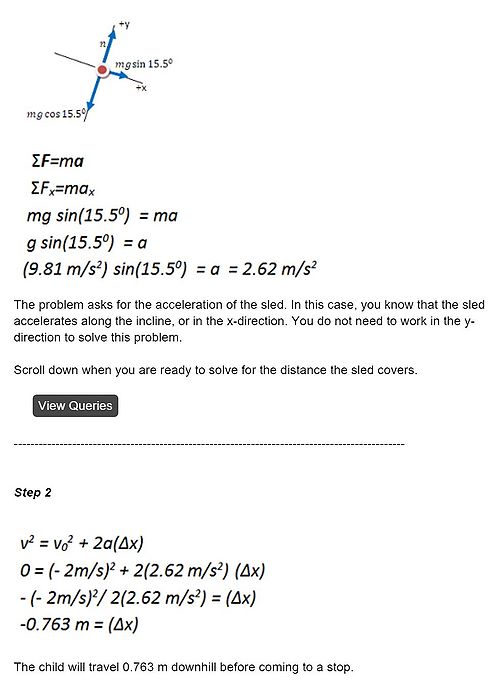Newton's Second Law of Motion
This topic covers Newton's Second Law of Motion.
The Main Idea
Newton's second law of motion states the explicit relationship between force on an object and the change in its momentum with respect to time.
A Mathematical Model
Momentum Form: [math]\displaystyle{ {\frac{d\vec{p}}{dt}}_{system} = \vec{F}_{net} }[/math] where p is the momentum of the system and F is the net force from the surroundings.
Acceleration form: [math]\displaystyle{ {\vec{F}_{net} = m}{\vec{a}} }[/math] where F_net is the net force on the system in Newtons, m is the mass of the system in Kg and a is the acceleration of the system in m/s^2.
Gravitational Extension: [math]\displaystyle{ {\vec{F}_{gravity} = G}{\frac{M_{1}M_{2}}{r^2}} }[/math]
A Computational Model
Glowscript Binary start program: http://www.glowscript.org/#/user/GlowScriptDemos/folder/Examples/program/BinaryStar-VPython
vPython code from the above program:
GlowScript 1.1 VPython
- Binary star
scene.caption.append(""" Right button drag or Ctrl-drag to rotate "camera" to view scene. To zoom, drag with middle button or Alt/Option depressed, or use scroll wheel.
On a two-button mouse, middle is left + right.
Touch screen: pinch/extend to zoom, swipe or two-finger rotate.""")
scene.forward = vector(0,-.3,-1)
G = 6.7e-11
giant = sphere(pos=vector(-1e11,0,0), radius=2e10, color=color.red,
make_trail=True, trail_type='points', interval=10, retain=50)
giant.mass = 2e30 giant.p = vector(0, 0, -1e4) * giant.mass
dwarf = sphere(pos=vector(1.5e11,0,0), radius=1e10, color=color.yellow,
make_trail=True, interval=10, retain=40)
dwarf.mass = 1e30 dwarf.p = -giant.p
dt = 1e5 while True:
rate(200)
r = dwarf.pos - giant.pos F = G * giant.mass * dwarf.mass * norm(r) / mag2(r) giant.p = giant.p + F*dt dwarf.p = dwarf.p - F*dt giant.pos = giant.pos + (giant.p/giant.mass) * dt dwarf.pos = dwarf.pos + (dwarf.p/dwarf.mass) * dt
This Program uses the gravitational extension of Newton's second law to visually represent the orbits of a binary star system.
Examples
Be sure to show all steps in your solution and include diagrams whenever possible
Simple
Question: A box is pushed on a frictionless surface with a force of 10N it accelerates to the right at 2m/s^2. What is the mass of the box?
Answer: Using the acceleration form of the second law, F=ma: it can be found that the box has a mass of 5kg.
Middling
Question: An 85kg skydiver is in free-fall. At some time later he experiences an air resistance force of 700N. Is he still accelerating and if so what is this acceleration?
Answer: To find out if he is still accelerating the net force on the skydiver needs to be found. After drawing a Free Body Diagram it can be seen that he is experiencing a gravitational force of 833N ((9.8m/s^2)*(85kg)) downwards and an air resistance force of 700N upwards. These are not in balance so he is still accelerating with a net force of 133N downwards. Using F=ma, it can be found that at that exact moment in time the skydiver's acceleration is 1.565m/s^2.
Difficult
Question:A child on a sled has been given a push so that she is moving up a hill. The hill is covered with icy snow and can be treated as frictionless. The child has a mass of 22.7 kg; the sled has a mass of 3.18 kg. What is the acceleration of the child as she moves up the incline? How far will she go before coming to a stop if her speed is 2 m/s when she starts at the bottom of the hill? She holds on tightly and so does not fall off the sled, and the hill makes an angle of 15.5 0 with the horizontal. Problem found from http://www.uwgb.edu/fenclh/problems/dynamics/2D/3/
Connectedness
- How is this topic connected to something that you are interested in?
I am very interested in physical interactions on a celestial scale. From the inteactions between planets and there moons to how entire galaxies move, Newton's second law if vital to describing and understanding these interactions.
- How is it connected to your major?
As an Aerospace Engineer, mechanics as a whole is a vital tool when designing any device or form of machinery. Knowing how your work with interact with its surroundings is very necessary within all fields of engineering.
- Is there an interesting industrial application?
Every moving part in every machine ever built is bound by Newton's second law.
History
Who:Isaac Newton working off of Kepler's "Law of Constant Area" and the principle of Galilean Relativity (http://physics.ucr.edu/~wudka/Physics7/Notes_www/node47.html).
What:Newton established a direct relationship between force and the second derivative of position (acceleration).
Where:Cambridge within his work titled: "Philosophiae Naturalis Principia Mathematica"
When:1687
Why:Because SCIENCE.
See also
Sir Isaac Newton: http://www.physicsbook.gatech.edu/Sir_Isaac_Newton
Newton's First Law: http://www.physicsbook.gatech.edu/Newton%27s_First_Law_of_Motion
Mass: http://www.physicsbook.gatech.edu/Mass
Further reading
NASA's Explanation: https://www.grc.nasa.gov/www/K-12/airplane/newton2.html
Study.com's lesson: http://study.com/academy/lesson/newtons-second-law-of-motion-the-relationship-between-force-and-acceleration.html
External links
Mandatory Khan Academy link: https://www.khanacademy.org/science/physics/forces-newtons-laws/newtons-laws-of-motion/v/newton-s-second-law-of-motion
References
http://www.physicsclassroom.com/class/newtlaws/Lesson-3/Newton-s-Second-Law
Matter and Interactions: Modern Mechanics. Volume One. 4th Edition.
Page Created by: Joshua Ingersoll November 20, 2015 <-- For Credit
